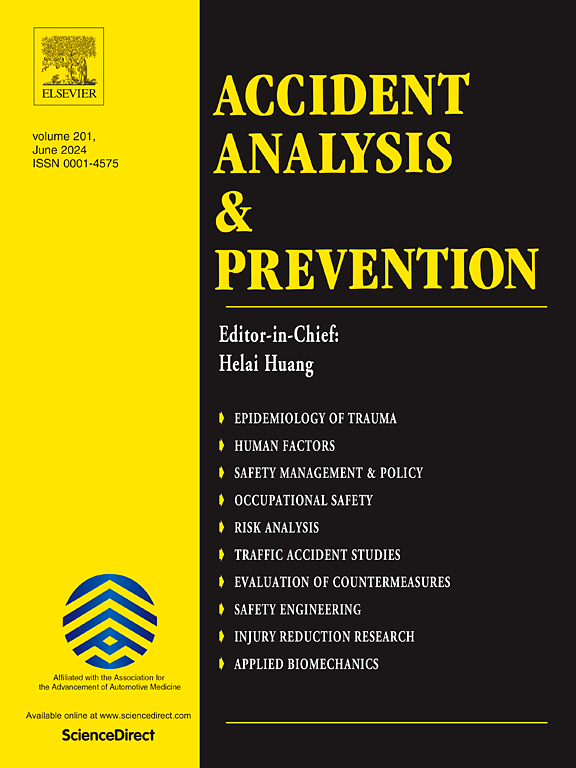Examining the impact of centerline rumble strips on reducing rural two-lane head-on collisions in Maine
IF 5.7
1区 工程技术
Q1 ERGONOMICS
引用次数: 0
Abstract
Among all traffic collisions, lane departure crashes are the leading type of serious traffic crashes in Maine, comprising 73% of statewide traffic fatalities. To reduce these crashes, the Maine Department of Transportation (MaineDOT) installed shoulder and centerline rumble strips on roadways to prevent lane departure crashes. Specifically, 511 miles of centerline rumble strips were installed on undivided bidirectional rural two-lane roadways to prevent head-on collisions. Given the severity of head-on collisions, coupled with significant investment in rumble strip installation, there is a need to understand the impact of rumble strips in reducing lane departure crashes. This study uses observational before-and-after studies with two methods: comparison group, and empirical Bayes (EB) comparison group to explore the effectiveness of centerline rumble strips in reducing head-on and opposite sideswipe crashes on rural two-lane roadways and compute crash modification factors (CMFs) in Maine. The evaluation investigated the impact of centerline rumble strips on reducing both the total as well as fatal and injury head-on and sideswipe collisions on rural two-lane roadways. The economic benefits of using rumble strips are also explored using a benefit-cost ratio analysis. This study finds that the installation of centerline rumble strips is associated with reductions of 28%-48% of head-on and opposite sideswipe collisions on rural two-lane roads. In addition, the benefits of the rumble strip installations are at least 14 times the cost. The centerline rumble strips are cost-effective countermeasures to reduce head-on collisions on rural two-lane roadways in Maine.
研究中心线隆隆声带对减少缅因州乡村双车道正面碰撞事故的影响
在所有交通事故中,车道偏离事故是缅因州严重交通事故的主要类型,占全州交通事故死亡人数的73%。为了减少这些事故,缅因州交通部(MaineDOT)在道路上安装了肩部和中心线的隆隆声带,以防止车道偏离事故。具体来说,511英里的中心线隆隆带被安装在未分割的双向农村双车道道路上,以防止正面碰撞。考虑到正面碰撞的严重性,再加上在隆隆声条安装上的大量投资,有必要了解隆隆声条在减少车道偏离事故方面的影响。本研究采用对比组和实证贝叶斯(EB)对比组两种方法进行前后观察研究,探讨了在缅因州农村双车道道路上设置中心线轰鸣带减少迎面和对侧碰撞的有效性,并计算了碰撞修正因子(CMFs)。评价研究了在农村双车道道路上设置中心线隆隆声带对减少总碰撞以及迎面和侧击碰撞的致命和伤害的影响。并通过效益成本比分析,探讨了使用隆隆声带的经济效益。这项研究发现,在农村双车道道路上,安装中心线轰鸣带可以减少28%-48%的正面和对侧碰撞。此外,隆隆声条安装的好处至少是成本的14倍。在缅因州的乡村双车道公路上,中心线的隆隆声带是减少正面碰撞的经济有效的对策。
本文章由计算机程序翻译,如有差异,请以英文原文为准。
求助全文
约1分钟内获得全文
求助全文
来源期刊

Accident; analysis and prevention
Multiple-
CiteScore
11.90
自引率
16.90%
发文量
264
审稿时长
48 days
期刊介绍:
Accident Analysis & Prevention provides wide coverage of the general areas relating to accidental injury and damage, including the pre-injury and immediate post-injury phases. Published papers deal with medical, legal, economic, educational, behavioral, theoretical or empirical aspects of transportation accidents, as well as with accidents at other sites. Selected topics within the scope of the Journal may include: studies of human, environmental and vehicular factors influencing the occurrence, type and severity of accidents and injury; the design, implementation and evaluation of countermeasures; biomechanics of impact and human tolerance limits to injury; modelling and statistical analysis of accident data; policy, planning and decision-making in safety.
 求助内容:
求助内容: 应助结果提醒方式:
应助结果提醒方式:


